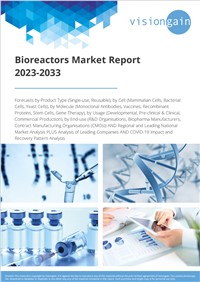The Bioreactors Market Report 2023-2033: This report will prove invaluable to leading firms striving for new revenue pockets if they wish to better understand the industry and its underlying dynamics. It will be useful for companies that would like to expand into different industries or to expand their existing operations in a new region.
Increasing Demand for Single-use Bioreactors
The increasing use of single-use bioreactors is a notable trend in the bioprocessing industry, driven by several compelling growth factors. Firstly, single-use bioreactors offer enhanced flexibility and scalability, enabling biopharmaceutical companies to adapt quickly to changing production needs and efficiently produce a wide range of biologics, from small batches to large-scale operations. Secondly, they mitigate the risk of cross-contamination, ensuring product integrity and safety while simplifying cleaning and validation processes. Additionally, the reduced capital and operational costs associated with single-use systems make them an attractive option for both established companies and emerging biotech start-ups. Furthermore, the growing focus on sustainability and reducing the environmental impact of bioprocessing has led to increased adoption of single-use technologies, as they typically generate less waste and require fewer resources compared to traditional stainless-steel bioreactors. As a result, the utilization of single-use bioreactors is poised to continue its ascent, reshaping the landscape of bioprocessing in the pharmaceutical and biotechnology sectors.
Limited Capacity of Single-use Bioreactors Likely to Hinder Large-scale Industrial Production
Single-use bioreactors are generally smaller in scale compared to their stainless-steel counterparts, which poses challenges for companies that require large-scale production of biopharmaceuticals. This limitation can hinder the ability to meet the growing demand for biologics, particularly in the case of blockbuster drugs or vaccines. Manufacturers may face scalability issues when transitioning from small-scale research and development to commercial production, necessitating multiple units or continuous operation, which can increase costs and complexity. As the industry continues to expand, addressing the capacity constraints of single-use bioreactors will be crucial to fully capitalize on their advantages while meeting the demands of a rapidly evolving biopharmaceutical market.
What Questions Should You Ask before Buying a Market Research Report?
- How is the bioreactors market evolving?
- What is driving and restraining the Bioreactors Market?
- How will each bioreactors submarket segment grow over the forecast period and how much revenue will these submarkets account for in 2033?
- How will the market shares for each bioreactors submarket develop from 2023 to 2033?
- What will be the main driver for the overall market from 2023 to 2033?
- Will leading bioreactors markets broadly follow the macroeconomic dynamics, or will individual national markets outperform others?
- How will the market shares of the national markets change by 2033 and which geographical region will lead the market in 2033?
- Who are the leading players and what are their prospects over the forecast period?
- What are the bioreactors projects for these leading companies?
- How will the industry evolve during the period between 2023 and 2033? What are the implications of bioreactors projects taking place now and over the next 10 years?
- Is there a greater need for product commercialisation to further scale the bioreactors market?
- Where is the bioreactors market heading and how can you ensure you are at the forefront of the market?
- What are the best investment options for new product and service lines?
- What are the key prospects for moving companies into a new growth path and C-suite?
You need to discover how this will impact the Bioreactors Market today, and over the next 10 years:
- Our 2830page report provides 119 tables, 183 charts/graphs exclusively to you.
- The report highlights key lucrative areas in the industry so you can target them – NOW.
- It contains in-depth analysis of global, regional and national sales and growth.
- It highlights for you the key successful trends, changes and revenue projections made by your competitors.
This report tells you TODAY how the Bioreactors Market will develop in the next 10 years, and in line with the variations in COVID-19 economic recession and bounce. This market is more critical now than at any point over the last 10 years.
Forecasts to 2033 and other analyses reveal commercial prospects
- In addition to revenue forecasting to 2033, our new study provides you with recent results, growth rates, and market shares.
- You will find original analyses, with business outlooks and developments.
- Discover qualitative analyses (including market dynamics, drivers, opportunities, restraints and challenges), cost structure, impact of rising Bioreactor prices and recent developments.
This report includes data analysis and invaluable insight into how COVID-19 will affect the industry and your company. Four COVID-19 recovery patterns and their impact, namely, “V”, “L”, “W” and “U” are discussed in this report.
Segments Covered in the Report
Product
- Single-use
- Reusable
Cell
- Mammalian Cells
- Bacterial Cells
- Yeast Cells
- Others
Molecule
- Monoclonal Antibodies
- Vaccines
- Recombinant Proteins
- Stem Cells
- Gene Therapy
- Others
Usage
- Developmental
- Pre-clinical & Clinical
- Commercial Production
End-users
- R&D Organisations
- Biopharma Manufacturers
- Contract Manufacturing Organisations (CMOs)



